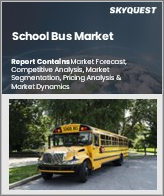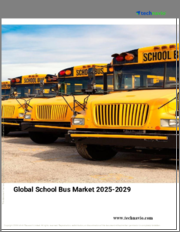
|
시장보고서
상품코드
1528884
스쿨버스 시장 : 추진별, 클래스별, 최종 용도별, 예측(2024-2032년)School Bus Market - By Propulsion (Diesel, Hybrid, Electric), By Class (Type A, Type B, Type C, Type D), By End-use (School District, Private Contractor, Charter Services) & Forecast, 2024 - 2032 |
||||||
스쿨버스 시장 규모는 2024년부터 2032년까지 연평균 6% 이상의 CAGR을 기록할 것으로 추정됩니다.
이러한 배경에는 학생들의 안전이 점점 더 중요해지고 학교 교통에 대한 정부의 규제가 강화되고 있기 때문입니다. 각국 정부는 엄격한 안전 기준과 가이드라인을 시행하고 있으며, 학교는 첨단 안전 기능을 갖춘 인증 및 정비된 스쿨버스를 도입해야 합니다. 예를 들어, 2024년 5월, CalAmp는 스쿨버스 운영업체가 차량을 실시간으로 모니터링하고 제어하여 원활한 운행과 정시 운행을 보장할 수 있도록 지원했습니다.
환경오염과 자동차 배기가스의 영향에 대한 우려가 커지면서 전기 버스와 하이브리드 스쿨버스에 대한 수요가 증가하고 있습니다. 정부와 교육청은 친환경 교통수단에 대한 투자를 늘리고 친환경 버스 도입에 대한 인센티브를 제공하고 있습니다. 이러한 지속가능한 교통수단으로의 전환은 배터리 수명 및 충전 인프라 개선 등 전기자동차 기술의 발전으로 더욱 뒷받침되고 있으며, 이는 전기 스쿨버스를 실행 가능하고 매력적인 대안으로 만들고 있습니다.
산업은 추진, 클래스, 최종 용도 및 지역으로 분류됩니다.
추진력을 바탕으로 하이브리드 부문 스쿨버스 시장 규모는 기존 버스와 전기 버스의 장점을 결합하여 보다 지속가능하고 비용 효율적인 운송 솔루션을 제공하는 능력으로 인해 2032년까지 강력한 CAGR을 기록할 것으로 예상됩니다. 하이브리드 스쿨버스는 기존 디젤 버스에 비해 연료 소비와 배기가스 배출량을 크게 감소시켜 학군이 탄소 배출량을 줄이고 환경 규제를 충족하는 데 필수적인 요소로 자리 잡았습니다.
민간 계약자 최종 용도 부문의 스쿨버스 시장은 학군에 비용 효율적이고 효율적이며 신뢰할 수 있는 운송 솔루션을 제공해야 한다는 강력한 요구에 힘입어 2024년부터 2032년까지 상당한 CAGR을 기록할 것으로 예상됩니다. 민간 공급업체는 정기적 인 유지보수 및 안전 규정 준수를 보장하기 위해 대규모 차량을 관리 할 수있는 자원과 전문 지식을 보유하고 있습니다.
아시아태평양의 스쿨버스 산업은 급속한 도시화와 이에 따른 교육 인프라 확대로 인해 2024년부터 2032년까지 지속적인 성장세를 보일 것으로 예상됩니다. 이 지역에서는 도시가 발전하고 학생 수 증가에 대응하기 위해 많은 학교가 설립됨에 따라 신뢰할 수 있고 효율적인 학교 교통 솔루션에 대한 요구가 증가하고 있습니다. 특히 농촌 및 교외 지역의 교육 접근성을 개선하려는 정부의 노력은 APAC 전역에서 스쿨버스에 대한 수요를 더욱 증가시킬 것으로 보입니다.
목차
제1장 조사 방법과 조사 범위
제2장 주요 요약
제3장 업계 인사이트
- 생태계 분석
- 공급업체 상황
- 원재료 공급업체
- 부품 공급업체
- 제조업체
- 서비스·프로바이더
- 유통 채널
- 최종사용자
- 이익률 분석
- 기술과 혁신 전망
- 특허 분석
- 주요 뉴스
- 규제 상황
- 영향요인
- 성장 촉진요인
- 전기 스쿨버스의 도입에 대한 정부 지원 정책
- 배터리 기술 향상
- 북미의 충전 인프라 정비 증가
- 효율적인 공공 교통 시스템을 필요로 하는 도시화 진전
- 신뢰성 높은 교통 인프라를 필요로 하는 교육기관 확대
- 업계의 잠재적 리스크와 과제
- 스쿨버스의 높은 초기 비용
- 성장 촉진요인
- 성장 가능성 분석
- Porters 분석
- PESTEL 분석
제4장 경쟁 상황
- 소개
- 기업 점유율 분석
- 경쟁 포지셔닝 매트릭스
- 전략 전망 매트릭스
제5장 시장 추정과 예측 : 추진별, 2021-2032년
- 주요 동향
- 디젤
- 하이브리드
- 전기
제6장 시장 추정과 예측 : 클래스별, 2021-2032년
- 주요 동향
- 유형 A
- 유형 B
- 유형 C
- 유형 D
제7장 시장 추정과 예측 : 최종 용도별, 2021-2032년
- 주요 동향
- 학군
- 민간 계약자
- 차터 서비스
제8장 시장 추정과 예측 : 지역별, 2021-2032년
- 주요 동향
- 북미
- 미국
- 캐나다
- 유럽
- 영국
- 독일
- 프랑스
- 이탈리아
- 러시아
- 벨기에
- 스웨덴
- 기타 유럽
- 아시아태평양
- 중국
- 인도
- 일본
- 한국
- 인도네시아
- 태국
- 베트남
- 기타 아시아태평양
- 라틴아메리카
- 브라질
- 멕시코
- 아르헨티나
- 기타 라틴아메리카
- 중동 및 아프리카
- 남아프리카공화국
- UAE
- 사우디아라비아
- 이란
- 터키
- 기타 중동 및 아프리카
제9장 기업 개요
- Blue Bird Corporation
- Carpenter Bus Sales
- Collins Bus Corporation
- Forest River
- Gillig LLC
- Girardin Minibus
- IC Bus(Navistar)
- Lion Electric Co.
- Micro Bird Inc.
- Proterra Inc.
- Starcraft Bus
- Thomas Built Buses
- Thoroughly Tiny Transit
- Trans Tech
- Van-Con, Inc.
School bus market size is estimated to record over 6% CAGR during 2024-2032, driven by the increasing emphasis on student safety and the implementation of stringent government regulations regarding school transportation. Governments across various regions are enforcing strict safety standards and guidelines that compel schools to adopt certified and well-maintained school buses equipped with advanced safety features. For instance, in May 2024, CalAmp allowed school bus operators to monitor and control their vehicles in real time for ensuring that they are running smoothly and on schedule.
With growing concerns about environmental pollution and the impacts of vehicular emissions, there is rising demand for electric and hybrid school buses. Governments and school districts are increasingly investing in green transportation initiatives and providing incentives for the adoption of Eco-friendly buses. This shift towards sustainable transportation is further supported by advancements in electric vehicle technology, such as improved battery life and charging infrastructure, making electric school buses a viable and attractive option.
The industry is classified into propulsion, class, end-use and region.
Based on propulsion, the school bus market size from the hybrid segment is slated to record strong CAGR through 2032 due to its ability to combine the benefits of traditional and electric buses for offering a more sustainable and cost-effective transportation solution. Hybrid school buses significantly reduce fuel consumption and emissions compared to conventional diesel buses, making them essential for school districts in meeting environmental regulations with a reduced carbon footprint.
School bus market from the private contractor end-use segment is projected to observe a substantial CAGR between 2024 and 2032 backed by the strong need for offering cost-effective, efficient, and reliable transportation solutions for school districts. Private contractors have the resources and expertise to manage large fleets to ensure regular maintenance and compliance with safety regulations, which can be challenging for individual school districts to handle.
Asia Pacific school bus industry will witness sustained growth from 2024 - 2032 attributed to the rapid urbanization and the resulting expansion of educational infrastructure. As cities grow and more schools are established to accommodate the increasing student population in the region, the need for reliable and efficient school transportation solutions is rising. Government initiatives aimed at improving education access, particularly in rural and suburban areas, will further boost demand for school buses across APAC.
Table of Contents
Chapter 1 Methodology & Scope
- 1.1 Research design
- 1.1.1 Research approach
- 1.1.2 Data collection methods
- 1.2 Base estimates and calculations
- 1.2.1 Base year calculation
- 1.2.2 Key trends for market estimates
- 1.3 Forecast model
- 1.4 Primary research & validation
- 1.4.1 Primary sources
- 1.4.2 Data mining sources
- 1.5 Market definitions
Chapter 2 Executive Summary
- 2.1 Industry 360° synopsis, 2021 - 2032
Chapter 3 Industry Insights
- 3.1 Industry ecosystem analysis
- 3.2 Supplier landscape
- 3.2.1 Raw material suppliers
- 3.2.2 Component suppliers
- 3.2.3 Manufacturers
- 3.2.4 Service providers
- 3.2.5 Distribution channel
- 3.2.6 End users
- 3.3 Profit margin analysis
- 3.4 Technology & innovation landscape
- 3.5 Patent analysis
- 3.6 Key news & initiatives
- 3.7 Regulatory landscape
- 3.8 Impact forces
- 3.8.1 Growth drivers
- 3.8.1.1 Supportive government policies for electric school bus deployment
- 3.8.1.2 Improve in battery technology
- 3.8.1.3 Increasing development of charging infrastructure in North America
- 3.8.1.4 Rising urbanization necessitating efficient public school transportation systems
- 3.8.1.5 Expansion of educational institutions requiring reliable transportation infrastructure
- 3.8.2 Industry pitfalls & challenges
- 3.8.2.1 High initial cost of school buses
- 3.8.1 Growth drivers
- 3.9 Growth potential analysis
- 3.10 Porter's analysis
- 3.11 PESTEL analysis
Chapter 4 Competitive Landscape, 2023
- 4.1 Introduction
- 4.2 Company market share analysis
- 4.3 Competitive positioning matrix
- 4.4 Strategic outlook matrix
Chapter 5 Market Estimates & Forecast, By Propulsion, 2021 - 2032 ($Mn & Units)
- 5.1 Key trends
- 5.2 Diesel
- 5.3 Hybrid
- 5.4 Electric
Chapter 6 Market Estimates & Forecast, By Class, 2021 - 2032 ($Mn & Units)
- 6.1 Key trends
- 6.2 Type A
- 6.3 Type B
- 6.4 Type C
- 6.5 Type D
Chapter 7 Market Estimates & Forecast, By End-Use, 2021 - 2032 ($Mn & Units)
- 7.1 Key trends
- 7.2 School district
- 7.3 Private contractor
- 7.4 Charter services
Chapter 8 Market Estimates & Forecast, By Region, 2021 - 2032 ($Mn & Units)
- 8.1 Key trends
- 8.2 North America
- 8.2.1 U.S.
- 8.2.2 Canada
- 8.3 Europe
- 8.3.1 UK
- 8.3.2 Germany
- 8.3.3 France
- 8.3.4 Italy
- 8.3.5 Russia
- 8.3.6 Belgium
- 8.3.7 Sweden
- 8.3.8 Rest of Europe
- 8.4 Asia Pacific
- 8.4.1 China
- 8.4.2 India
- 8.4.3 Japan
- 8.4.4 South Korea
- 8.4.5 Indonesia
- 8.4.6 Thailand
- 8.4.7 Vietnam
- 8.4.8 Rest of Asia Pacific
- 8.5 Latin America
- 8.5.1 Brazil
- 8.5.2 Mexico
- 8.5.3 Argentina
- 8.5.4 Rest of Latin America
- 8.6 MEA
- 8.6.1 South Africa
- 8.6.2 UAE
- 8.6.3 Saudi Arabia
- 8.6.4 Iran
- 8.6.5 Turkey
- 8.6.6 Rest of MEA
Chapter 9 Company Profiles
- 9.1 Blue Bird Corporation
- 9.2 Carpenter Bus Sales
- 9.3 Collins Bus Corporation
- 9.4 Forest River
- 9.5 Gillig LLC
- 9.6 Girardin Minibus
- 9.7 IC Bus (Navistar)
- 9.8 Lion Electric Co.
- 9.9 Micro Bird Inc.
- 9.10 Proterra Inc.
- 9.11 Starcraft Bus
- 9.12 Thomas Built Buses
- 9.13 Thoroughly Tiny Transit
- 9.14 Trans Tech
- 9.15 Van-Con, Inc.



















